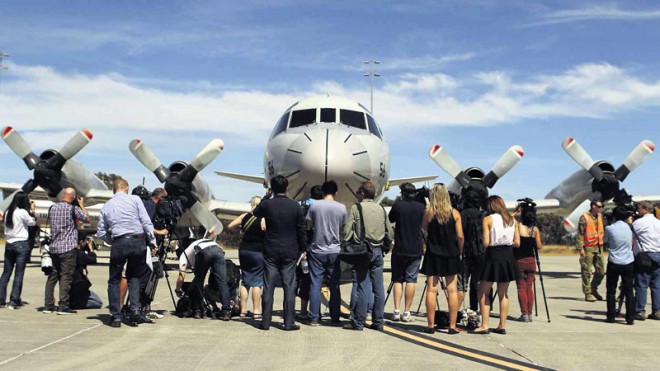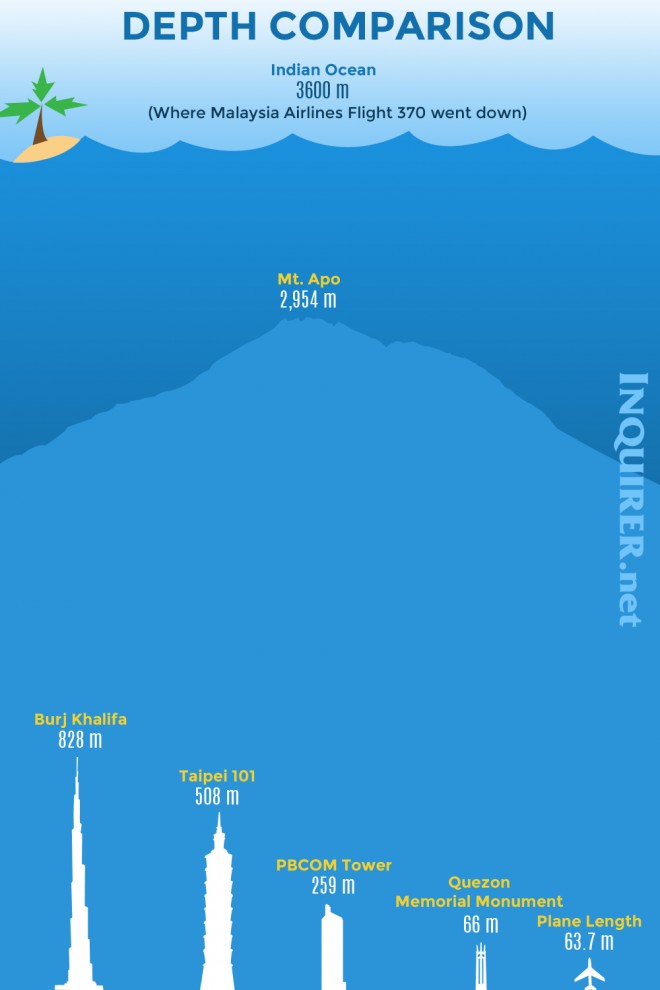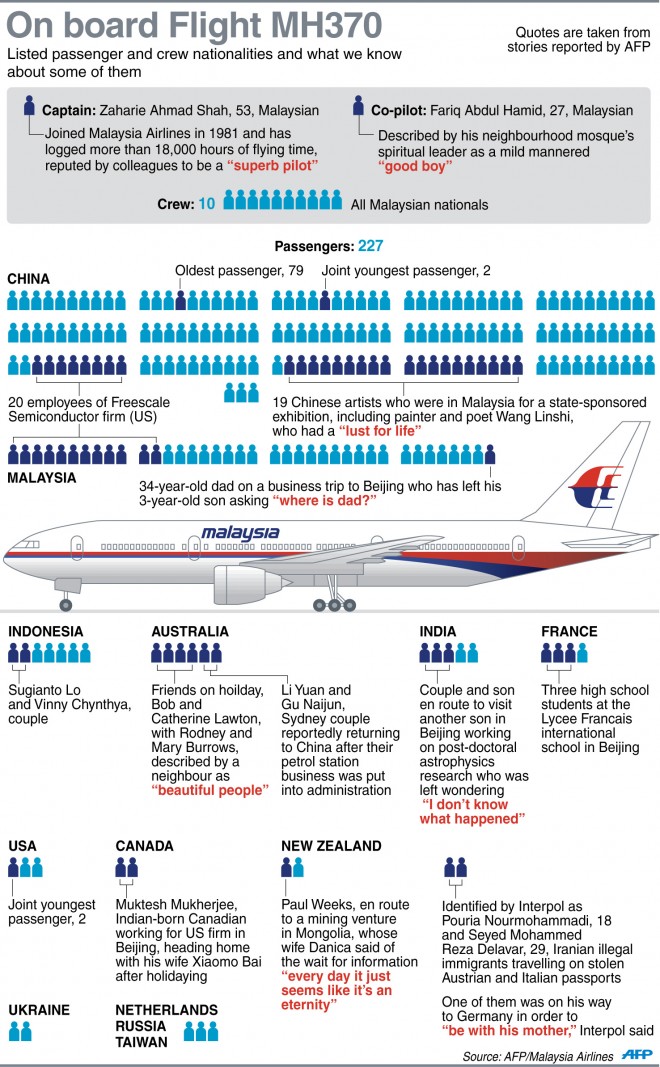KL confirms Malaysian Airlines Flight MH370 ended in Indian Ocean

SEARCH OVER? Journalists gather in front of a Japanese P-3 Orion at an Australian air base near Perth on Monday as ships and planes swarmed over the southern Indian Ocean looking for the missing Malaysian plane. AFP
KUALA LUMPUR—The missing Malaysia Airlines plane crashed into a remote corner of the Indian Ocean, the nation’s prime minister said Monday night, citing a new analysis of satellite data. The statement was the first major step toward resolving a 2-week-old mystery that has consumed the world.
But with the location of Flight 370 itself still unknown—most likely somewhere at the bottom of the sea—profound questions remain about what brought down the aircraft and why.
Dressed in a black suit, Prime Minister Najib Razak announced the news in a brief statement to reporters late Monday night, saying the information was based on an unprecedented analysis of satellite data.
He said the data indicated that the Boeing 777, which took off from Kuala Lumpur for Beijing on March 8 with 239 passengers and crew, flew “to a remote location, far from any possible landing sites.”
“It is therefore with deep sadness and regret that I must inform you that, according to this new data, Flight MH370 ended in the southern Indian Ocean.”
Article continues after this advertisementHe said that Inmarsat, the company that indicated the plane flew along northern and southern corridors, had managed to trace its flight path, using sophisticated technology.
“Using a type of analysis never before used in an investigation of this sort, they have been able to shed more light on MH370’s flight path,” Najib said.
Based on their new analysis, Inmarsat and the UK Air Accidents Investigation Branch (AAIB) had concluded that MH370 flew along the southern corridor, and that its last position was in the middle of the Indian Ocean, west of Perth, he said.
“This is a remote location, far from any possible landing sites,” he said. “It is therefore with deep sadness and regret that I must inform you that, according to this new data, Flight MH370 ended in the southern Indian Ocean.”
Najib added that the families of those on board had been informed of the developments.
He said a news conference would be held on Tuesday with further details about the latest findings.
“In the meantime, we wanted to inform you of this new development at the earliest opportunity. We share this information out of a commitment to openness and respect for the families, two principles which have guided this investigation,” Najib said.
‘No words to ease pain’
The airline, in a statement sent to families, said “we have to assume” the plane was lost.
“Our prayers go out to all the loved ones of the 226 passengers and of our 13 friends and colleagues at this enormously painful time,” it said.
“We know there are no words that we or anyone else can say which can ease your pain.”
The airline said the multinational search, which is scouring a stretch of the forbidding Indian Ocean to find any debris, would continue “as we seek answers to the questions which remain.”
Malaysia believes the plane was deliberately diverted by someone on board. But the absence of firm evidence has fueled intense speculation and conspiracy theories, and tormented the families of the missing.
Leading theories include a hijacking, pilot sabotage, or a sudden mid-air crisis that incapacitated the flight crew and left the plane to fly on auto-pilot until it ran out of fuel.

Malaysia’s Prime Minister Najib Razak speaks during the press conference for the missing Malaysia Airline, MH370 at Putra World Trade Centre (PWTC) in Kuala Lumpur, Malaysia, Monday, March 24, 2014. Razak says new data show missing plane plunged into southern Indian Ocean. (AP Photo/Vincent Thian)
MH370 last made contact over the South China Sea halfway between Malaysia and Vietnam. For reasons unknown, it backtracked over the Malaysian peninsula and then flew on for hours.
The search swung deep into the Indian Ocean last week after initial satellite images depicted large floating objects there.
Hopes of a resolution to the mystery rose after a weekend in which an Australian aircraft spotted a wooden pallet, strapping and other debris, and French and Chinese satellite information indicated more floating objects.
Wooden pallets are most commonly used by ships but are also used in airplane cargo holds, and an official with Malaysia Airlines said on Sunday night that the flight was, in fact, carrying wooden pallets. The official was speaking on condition of anonymity in keeping with company policy.
An Australian-led multinational air and sea search has been scouring the vast ocean and there were two separate sightings Wednesday of possible debris from the plane.
Crew members of an Australian P-3 Orion plane reported seeing two objects, Australian Prime Minister Tony Abbott told parliament.
Australian officials said they were different to pieces seen by a Chinese plane earlier in the day.
The Australian naval ship HMAS Success, equipped with a crane, was in the area, about 2,500 kilometers (1,562 miles) southwest of Perth, and will attempt to recover the objects.
Abbott cautioned that it was not known whether the objects came from the missing Boeing 777.
“Nevertheless we are hopeful that we can recover these objects soon and they will take us a step closer to resolving this tragic mystery,” he said..
Australia said a US Navy plane searching the area on Monday had been unable to locate the objects.
China has diverted its icebreaker Xuelong, or Snow Dragon, toward the location where the debris was spotted. A flotilla of other Chinese ships is also steadily making its way south.
The ships will start to arrive in the area on Tuesday.
The Chinese aircraft that spotted the objects was one of two IL-76s searching early on Monday. Another eight aircraft, from New Zealand, Australia, the United States and Japan, were scheduled to make flights throughout the day to the search site off Perth.
Difficult conditions
Aircraft flying on Monday were focused on searching by sight, rather than radar, which can be tricky to use because of the high seas and wind in the area.
“It’s a lot of water to look for just perhaps a tiny object,” Australian Deputy Prime Minister Warren Truss told Australian Broadcasting Corp. radio before the Chinese report.
“Today we expect the weather to deteriorate and the forecast ahead is not that good, so it’s going to be a challenge, but we will stick at it,” he said.
On Tuesday, a cold front was expected to move through the search area from the west, bringing showers, more low cloud and less visibility.
Tropical Cyclone “Gillian,” which is farther to the north, will not impact the area.
Australia was also analyzing French radar images showing potential floating debris that were taken some 850 km north of the current search area.
Australia has used a US satellite image of two floating objects to frame its search area. A Chinese satellite has also spotted an object floating in the ocean there, estimated at 22 m long and 13 m wide.
It could not be determined easily from the blurred images whether the objects were the same as those detected by the Australian and Chinese search planes, but the Chinese photograph could depict a cluster of smaller objects, said a senior military officer from one of the 26 nations involved in the search.

Malaysia PM Najib Razak announced Monday night that Malaysia Airlines flight #MH370 ended in Indian Ocean INFOGRAPHICS BY STRAITS TIMES/ASIA NEWS NETWORK
The wing of a Boeing 777-200ER is approximately 27 m long and 14 m wide at its base, according to estimates derived from publicly available scale drawings. Its fuselage is 63.7 m long by 6.2 m wide.
Hunt for ‘black box’
The US Navy has added to the sense of an approaching denouement, ordering a specialized device sent to the region to help find the “black box” flight and cockpit voice data—crucial in determining what happened to the plane.
The high-tech device can locate black boxes as deep as 20,000 feet (6,060 meters), the US Seventh Fleet said in a statement. The search area ranges from 3,000-4,000 meters deep.
The 30-day signal from the black box is due to fail in less than two weeks.
The Australian Maritime Safety Authority said the search grew to 10 aircraft on Monday with the inclusion of two Chinese military aircraft joining Australian, US, and Japanese planes.
China has also dispatched seven ships, adding to British and Australian naval vessels involved.
If a crash is confirmed, recovering the black box will be even more difficult than the case of the Air France jet that went down in the Atlantic in 2009, said Charitha Pattiaratchi, an oceanographer at the University of Western Australia.
“We have to remember that Air France 447 took two years to find and this is a more challenging region where the environment is much, much harsher. There are bigger waves and it’s windier,” he said.
As part of an investigation into the crash, Malaysian Transport Minister Hishammuddin Hussein said police have interviewed more than 100 people, including families of both the pilot and co-pilot.
Malaysia Airlines said Monday that 27-year-old co-pilot Fariq Abdul Hamid was flying the Boeing 777 for the first time without a so-called “check co-pilot” looking over his shoulder.
Originally posted: 10:07 pm | Monday, March 24th, 2014
RELATED STORIES
Ocean hunt for missing jet focuses on floating pallet
Australia spots two objects in jet search—Malaysia

